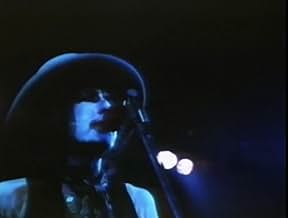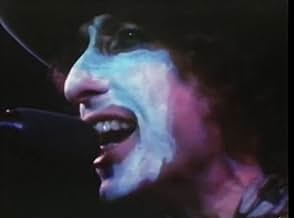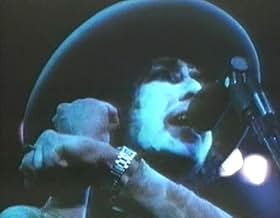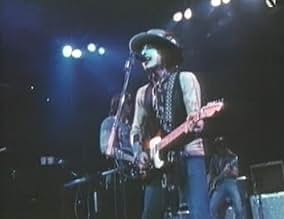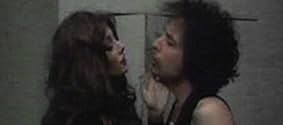Adicionar um enredo no seu idiomaBob Dylan on tour with the Rolling Thunder Revue in 1975; concert footage, documentary interviews and bizarre improvised character scenes.Bob Dylan on tour with the Rolling Thunder Revue in 1975; concert footage, documentary interviews and bizarre improvised character scenes.Bob Dylan on tour with the Rolling Thunder Revue in 1975; concert footage, documentary interviews and bizarre improvised character scenes.
- Prêmios
- 2 vitórias no total
Ramblin' Jack Elliott
- Longheno de Castro
- (as Jack Elliott)
Ruth Tyrangel
- The Girlfriend
- (as Ruth Tyrangiel)
J. Stephen Soles
- Ramon
- (as Steven Soles)
Avaliações em destaque
Quirky, idiosyncratic, often confusing and much too long mixture of concert footage, documentary and fictional scenes is definitely fascinating to watch, but one wonders, if Bob Dylan ever was certain about his intentions to create this film or whether he had an idea who its potential audience would be.
The movie was filled with bad acting.
Plus, this movie did Joan Baez extremely dirty, erasing the fact that Joan Baez dated Bob Dylan in 1964. In 1965 Bob Dylan cheated on Joan Baez with Sara Lownds, then he goes & re-write history in Renaldo and Clara, turning Joan into the 'other woman' in his fairy tale marriage.
Warning: At the timestamp of 3 hours 20 minutes, Bob Dylan starts gargling. What is this? A Cofsils experdine gargle commercial?
Alternate title of the movie: This Movie is a Giant Middle Finger to Joan Baez. Dump Joan Baez, break her heart, marry the other girl named Sara Lownds, and then flip the tables and cast Joan Baez as the other girl instead. Talk about erasing the truth, eh? Plus, gargle a while to make audience confused and make people fools for 4 hours straight and pretend it to be a cinematic masterpiece".
Plus, this movie did Joan Baez extremely dirty, erasing the fact that Joan Baez dated Bob Dylan in 1964. In 1965 Bob Dylan cheated on Joan Baez with Sara Lownds, then he goes & re-write history in Renaldo and Clara, turning Joan into the 'other woman' in his fairy tale marriage.
Warning: At the timestamp of 3 hours 20 minutes, Bob Dylan starts gargling. What is this? A Cofsils experdine gargle commercial?
Alternate title of the movie: This Movie is a Giant Middle Finger to Joan Baez. Dump Joan Baez, break her heart, marry the other girl named Sara Lownds, and then flip the tables and cast Joan Baez as the other girl instead. Talk about erasing the truth, eh? Plus, gargle a while to make audience confused and make people fools for 4 hours straight and pretend it to be a cinematic masterpiece".
The drama of Renaldo and Clara, set against Bob Dylan's Rolling Thunder Revue of 1975-76.
Part concert film, part drama, part documentary Bob Dylan's 'Renaldo and Clara' is a sprawling, disjointed, puzzling affair. The concert stuff is great, as one would expect. Dylan's Rolling Thunder Revue was a fantastic musical experience coming off the back of Dylan's excellent 'Desire' and 'Blood on the Tracks' albums and featuring Dylan at his most spontaneous, dynamic and, in terms of live performances, creative. Dylan had a great backing band (that included Mick Ronson, David Bowie's long-time guitarist) and the Revue also included big names such as Joan Baez and Roger McGuinn, performances of whose are also shown in the film.
For a Dylan fan like myself the music alone should be enough to give this film a thumbs up.
Unfortunately, it's not. The music makes around a third of this four-hour film and the remainder is very weak. The Renaldo and Clara drama is all over the place with a bare semblance of a plot and no character development or engagement.
The documentary side has some interesting bits to it: the roadies setting up the stage, some of the other background aspects to the tour, but for the most part it is like the drama, an uninteresting meander.
I really don't know what Dylan and co-writer Sam Shepard were thinking while penning the script for this or Dylan was thinking while directing and editing this. With Dylan's mountains of creativity it's not a surprise that he turned his hand to film: it's the execution that's the problem.
My one thought is that is that Dylan's songs often consist of seemingly-disjointed, stream-of-consciousness imagery and narratives and he tried to replicate that in a four-hour film. It works in a song because it's short enough that you don't need a neat, complete story, the listener can add their own interpretations and there's music so the narrative isn't all that matters. None of these mitigations apply in a feature film.
Dylan would have been far better off just releasing this as a concert film - no attempt at drama. After the full-length version bombed he did release a two-hour, mostly-concert, version of this but by then it was too late as fans had already written it off.
Part concert film, part drama, part documentary Bob Dylan's 'Renaldo and Clara' is a sprawling, disjointed, puzzling affair. The concert stuff is great, as one would expect. Dylan's Rolling Thunder Revue was a fantastic musical experience coming off the back of Dylan's excellent 'Desire' and 'Blood on the Tracks' albums and featuring Dylan at his most spontaneous, dynamic and, in terms of live performances, creative. Dylan had a great backing band (that included Mick Ronson, David Bowie's long-time guitarist) and the Revue also included big names such as Joan Baez and Roger McGuinn, performances of whose are also shown in the film.
For a Dylan fan like myself the music alone should be enough to give this film a thumbs up.
Unfortunately, it's not. The music makes around a third of this four-hour film and the remainder is very weak. The Renaldo and Clara drama is all over the place with a bare semblance of a plot and no character development or engagement.
The documentary side has some interesting bits to it: the roadies setting up the stage, some of the other background aspects to the tour, but for the most part it is like the drama, an uninteresting meander.
I really don't know what Dylan and co-writer Sam Shepard were thinking while penning the script for this or Dylan was thinking while directing and editing this. With Dylan's mountains of creativity it's not a surprise that he turned his hand to film: it's the execution that's the problem.
My one thought is that is that Dylan's songs often consist of seemingly-disjointed, stream-of-consciousness imagery and narratives and he tried to replicate that in a four-hour film. It works in a song because it's short enough that you don't need a neat, complete story, the listener can add their own interpretations and there's music so the narrative isn't all that matters. None of these mitigations apply in a feature film.
Dylan would have been far better off just releasing this as a concert film - no attempt at drama. After the full-length version bombed he did release a two-hour, mostly-concert, version of this but by then it was too late as fans had already written it off.
Renaldo And Clara was hit hard by critics, but was a true testimont that Bob Dylan (Robert Zimmerman) is the true modern leader of entertainment, and learder of social change.
P.S. I would also like to find somewhere where I can buy this movie.
P.S. I would also like to find somewhere where I can buy this movie.
These days most everything is inherently cinematic: poetry, music, literature.
That's a good thing if you understand how cinema works and can escape its control when needed. One technique is to retreat to non-cinematic art, to surf the various pathways therein and then come back to the moving image from the outside.
This film, if you can find the five hour version, can provide one such exercise. Dylan builds his songs around images, but they are not images from film or film-influenced phrases. His images are what appears in dreams, originating in real life and sliced and diced by drugs. (Incidentally, the period of this film marks the transition from active tripping of various kinds to passive by his "acceptance" of fundamentalism another drug.)
His method has always been to eschew a plan, to avoid premeditated structure, to abandon great themes. Instead, he just starts, waits for images and ideas to appear and then arranges them on the table. His art is a combination of selection and composition. The selection is a matter of discarding everything that seems to be simple. That automatically puts him in the world of the Tambourine Man, where he has been in various guises for decades.
The matter of composition is something else. He just trusts how they appear. Since they all come from one mind, and that mind is coherent and somewhat interesting, they hang together. He doesn't know how they do and has given up questioning, except for a brief period of examining Kabbalah.
That's how he does it with his music, and it works to judge from his audience. He also does it with his prose rambles. This works less well; the act of juxtaposing elements in his songs leverages the vocabulary of rhythmic associations he pretty much invented. But he has no equivalent to serve his writing projects, so most of them come across as sophomoric. Same with this film.
He just started. But images in film (at least films like this) have to come from things that are presented in the real world. He relies on some friends to help create and select the images/ scenes/sequences. Ginsberg is an anchor who does understand the rhythms of poetry where Bob does not, but he is as ignorant as Bob concerning film.
Another friend is Sam Shepard who is credited as co-writer. During this time, he was working with Terence Malick on another project which is about the same problem of selection. Shepard and Malick for that matter have a coherent theory of "selection" that they can use in conceiving their projects and setting the basic tone. We can see much of that here; it all relates to folding of persons into characters that are assignable to other bodies. Thus we have many "actors" playing more than one role; roles that are assigned to more than one actor; scenes that are copied from real life; lives that are generated from scenes (bordello vignettes, Indian cosmologies, Black injustices, beat poems...)
That's the selection half and it is interesting as all getout. The composition half is pure dreck. Dylan trusts his intuitions as he always does. But these pieces don't all come from the inner spinning of a whole mind like Kieslowski's or Tarkovsky's. They come from all over and he stitches them together as if they did actually come from his visions. But they didn't so it has no coherent being.
He tries to use songs, his and others, as glue. Some of these are enjoyable by themselves but they sure don't help assemble a cinematic being.
Ted's Evaluation -- 2 of 3: Has some interesting elements.
That's a good thing if you understand how cinema works and can escape its control when needed. One technique is to retreat to non-cinematic art, to surf the various pathways therein and then come back to the moving image from the outside.
This film, if you can find the five hour version, can provide one such exercise. Dylan builds his songs around images, but they are not images from film or film-influenced phrases. His images are what appears in dreams, originating in real life and sliced and diced by drugs. (Incidentally, the period of this film marks the transition from active tripping of various kinds to passive by his "acceptance" of fundamentalism another drug.)
His method has always been to eschew a plan, to avoid premeditated structure, to abandon great themes. Instead, he just starts, waits for images and ideas to appear and then arranges them on the table. His art is a combination of selection and composition. The selection is a matter of discarding everything that seems to be simple. That automatically puts him in the world of the Tambourine Man, where he has been in various guises for decades.
The matter of composition is something else. He just trusts how they appear. Since they all come from one mind, and that mind is coherent and somewhat interesting, they hang together. He doesn't know how they do and has given up questioning, except for a brief period of examining Kabbalah.
That's how he does it with his music, and it works to judge from his audience. He also does it with his prose rambles. This works less well; the act of juxtaposing elements in his songs leverages the vocabulary of rhythmic associations he pretty much invented. But he has no equivalent to serve his writing projects, so most of them come across as sophomoric. Same with this film.
He just started. But images in film (at least films like this) have to come from things that are presented in the real world. He relies on some friends to help create and select the images/ scenes/sequences. Ginsberg is an anchor who does understand the rhythms of poetry where Bob does not, but he is as ignorant as Bob concerning film.
Another friend is Sam Shepard who is credited as co-writer. During this time, he was working with Terence Malick on another project which is about the same problem of selection. Shepard and Malick for that matter have a coherent theory of "selection" that they can use in conceiving their projects and setting the basic tone. We can see much of that here; it all relates to folding of persons into characters that are assignable to other bodies. Thus we have many "actors" playing more than one role; roles that are assigned to more than one actor; scenes that are copied from real life; lives that are generated from scenes (bordello vignettes, Indian cosmologies, Black injustices, beat poems...)
That's the selection half and it is interesting as all getout. The composition half is pure dreck. Dylan trusts his intuitions as he always does. But these pieces don't all come from the inner spinning of a whole mind like Kieslowski's or Tarkovsky's. They come from all over and he stitches them together as if they did actually come from his visions. But they didn't so it has no coherent being.
He tries to use songs, his and others, as glue. Some of these are enjoyable by themselves but they sure don't help assemble a cinematic being.
Ted's Evaluation -- 2 of 3: Has some interesting elements.
Você sabia?
- CuriosidadesThe film got many negative reviews, and some theaters refused to show it. Most theaters showed a two-hour cut that was mostly concert footage. The original four-hour director's cut was first shown on European television years later.
- Citações
The Truck Driver: Why are you so much in a hurry? Is the law after you?
Renaldo: I am the law!
- Cenas durante ou pós-créditosThe opening credits end with a title card reading "A Film by BOB DYLAN" directed after he is credited as writer and director. The closing credits are divided in three sections, separated by wide time gaps, played over a different artist, soul singer Hal Frazier, performing "In The Morning", a song written by Barry Gibb.
- Versões alternativasOriginally released at 292 minutes (yes, that's almost five hours!). After dismal box office returns, Dylan shortened the film to 122 minutes removing almost all of the narrative storyline and leaving mostly concert footage.
- ConexõesFeatured in Bob Dylan: Change on the Tracks (2008)
- Trilhas sonorasWhen I Paint My Masterpiece
Written and performed by Bob Dylan
Principais escolhas
Faça login para avaliar e ver a lista de recomendações personalizadas
- How long is Renaldo and Clara?Fornecido pela Alexa
Detalhes
- Tempo de duração
- 3 h 55 min(235 min)
- Mixagem de som
- Proporção
- 1.85 : 1
Contribua para esta página
Sugerir uma alteração ou adicionar conteúdo ausente

